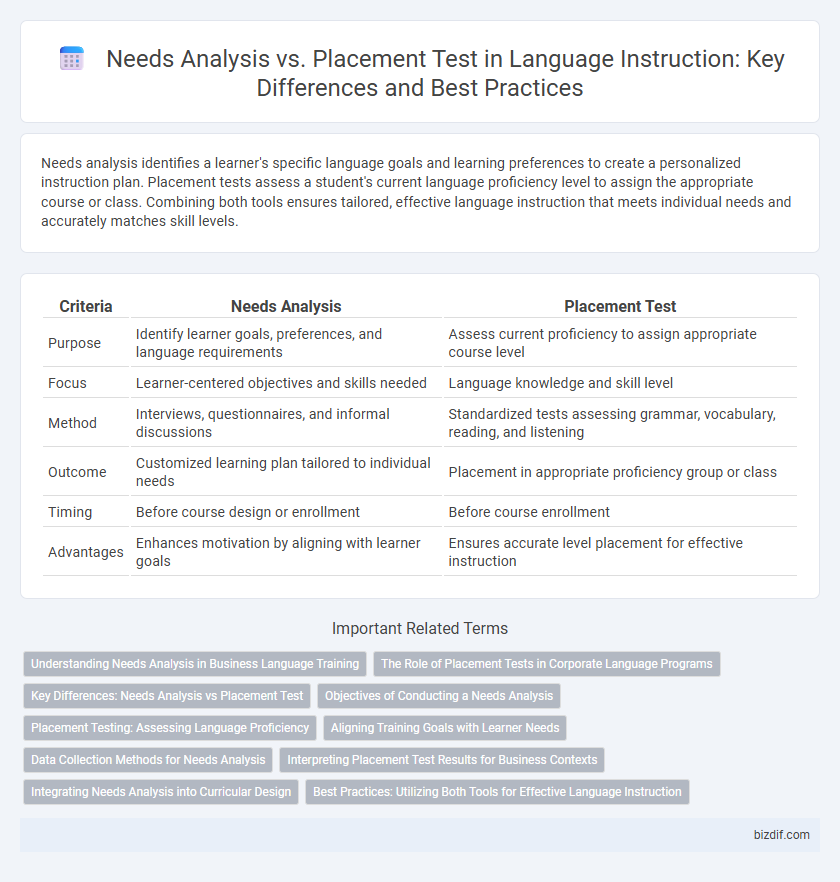Needs analysis identifies a learner's specific language goals and learning preferences to create a personalized instruction plan. Placement tests assess a student's current language proficiency level to assign the appropriate course or class. Combining both tools ensures tailored, effective language instruction that meets individual needs and accurately matches skill levels.
Table of Comparison
| Criteria | Needs Analysis | Placement Test |
|---|---|---|
| Purpose | Identify learner goals, preferences, and language requirements | Assess current proficiency to assign appropriate course level |
| Focus | Learner-centered objectives and skills needed | Language knowledge and skill level |
| Method | Interviews, questionnaires, and informal discussions | Standardized tests assessing grammar, vocabulary, reading, and listening |
| Outcome | Customized learning plan tailored to individual needs | Placement in appropriate proficiency group or class |
| Timing | Before course design or enrollment | Before course enrollment |
| Advantages | Enhances motivation by aligning with learner goals | Ensures accurate level placement for effective instruction |
Understanding Needs Analysis in Business Language Training
Needs analysis in business language training identifies specific communication goals and skill gaps to tailor instruction effectively, ensuring relevance to professional tasks. It involves gathering detailed information through surveys, interviews, and workplace observations to customize content for maximum learning impact. Unlike placement tests that assess current proficiency levels, needs analysis drives curriculum design by pinpointing exact learner requirements and industry demands.
The Role of Placement Tests in Corporate Language Programs
Placement tests in corporate language programs provide precise evaluations of employees' current language proficiency to tailor training effectively. These assessments identify skill gaps and group learners by ability, ensuring efficient resource allocation and targeted instruction. Unlike broad needs analysis, placement tests offer quantifiable data critical for setting clear learning objectives and tracking progress.
Key Differences: Needs Analysis vs Placement Test
Needs Analysis focuses on identifying learners' specific language goals, skills gaps, and contextual requirements through detailed questionnaires and interviews. Placement Tests evaluate existing language proficiency by measuring grammar, vocabulary, reading, and listening skills to assign appropriate course levels. While Needs Analysis guides personalized curriculum design, Placement Tests ensure accurate class placement based on measurable language ability.
Objectives of Conducting a Needs Analysis
Needs Analysis aims to identify learners' specific language goals, proficiency levels, and contextual requirements to tailor instruction effectively. It gathers qualitative and quantitative data on learners' motivations, challenges, and preferred learning styles to design targeted curricula. This process enhances learning outcomes by aligning teaching methods with students' unique needs rather than relying solely on placement tests that focus on current skill assessment.
Placement Testing: Assessing Language Proficiency
Placement testing accurately assesses language proficiency by evaluating listening, speaking, reading, and writing skills through standardized exams like the CEFR-aligned tests. These tests provide precise data on learners' current abilities, enabling educators to assign appropriate course levels and tailor instruction effectively. Reliable placement testing minimizes misplacement risks and ensures optimized language acquisition pathways.
Aligning Training Goals with Learner Needs
Needs analysis identifies learners' specific language goals, skills gaps, and contextual requirements by collecting detailed information through surveys, interviews, or diagnostic tasks. Placement tests measure proficiency levels to categorize learners into appropriate course tiers but may not fully capture individual learner objectives or motivational factors. Aligning training goals with learner needs requires integrating insights from both methods to tailor instruction that addresses precise learning outcomes and maximizes engagement.
Data Collection Methods for Needs Analysis
Needs analysis employs diverse data collection methods, including surveys, interviews, and focus groups, to gather detailed learner profiles and language goals. This approach prioritizes qualitative insights and contextual factors, enabling tailored curriculum design. Placement tests, by contrast, primarily utilize standardized assessments that measure current proficiency levels rather than individual learner motivations or specific needs.
Interpreting Placement Test Results for Business Contexts
Interpreting placement test results in business language instruction involves analyzing candidates' proficiency levels to align with specific corporate communication needs and job roles. Detailed evaluation of test components such as vocabulary, grammar, and comprehension ensures accurate placement in courses targeting industry-relevant skills like negotiations, presentations, and report writing. Effective interpretation supports tailored training programs that enhance employees' practical language use in business environments.
Integrating Needs Analysis into Curricular Design
Integrating Needs Analysis into curricular design improves language instruction by tailoring course content to specific learner goals, proficiency levels, and contexts, unlike placement tests which primarily assess existing skill levels. A thorough needs analysis gathers detailed information on learners' linguistic, cultural, and professional requirements, enabling educators to develop targeted materials and learning outcomes. This approach enhances student motivation and achievement by aligning instruction with individual and group needs rather than relying solely on generalized placement criteria.
Best Practices: Utilizing Both Tools for Effective Language Instruction
Needs analysis identifies learners' goals, preferences, and skill gaps through surveys, interviews, and self-assessments to tailor instruction effectively. Placement tests evaluate current language proficiency using standardized exams to group learners at appropriate levels and ensure curriculum alignment. Combining both tools enables instructors to customize content while accurately positioning students, maximizing engagement and learning outcomes.
Needs Analysis vs Placement Test Infographic

 bizdif.com
bizdif.com